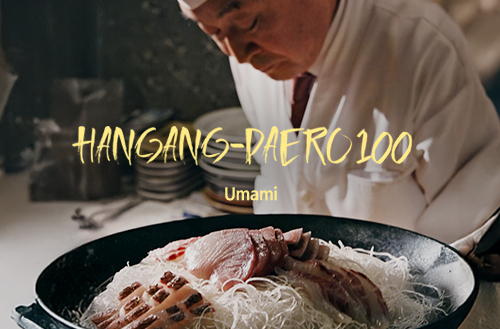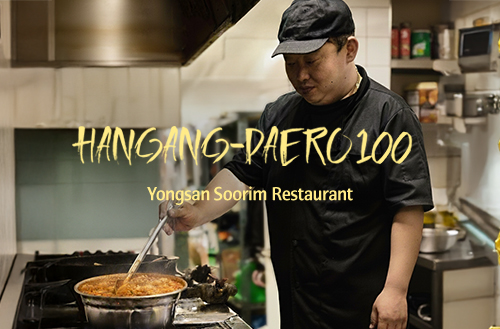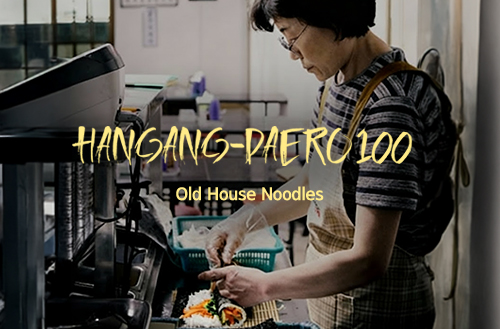

#100 Hangang-daero
2023.03.20
Interview with Linda Lee, CEO of Approach, an English-style brunch place

An old two-story house in an alley in Sinyongsan. Inside the gates is a beautifully decorated green garden filled with the scent of grass. Welcome to Approach, an English-style brunch cafe. Approach attracts customers from all over the country with its English-style brunch dishes that have captured the local vibe perfectly. Linda Lee, CEO of Approach, unfolds some behind-the-scenes stories of the brand, which she created with Amorepacific in mind.

▲ Linda Lee at Approach in Sinyongsan ⓒgoldenimageshouse
#1 Capturing the European hearts and minds with
K-food
K-food
You studied design in Paris. How did you end up working in the food business?
After studying design in Paris, I came back to Korea and started working at a design company. Because I had lived abroad for a substantial part of my life, I had a difficult time adjusting to the Korean corporate culture. Eventually, I quit. Then, I married my husband who was living in England at the time, and we moved to London. When the IMF hit and my husband’s business struggled, we came back to Korea. We were trying to figure out how to make ends meet when a friend of mine opened a barbecue restaurant. I went to the place, and I had a light bulb moment. ‘What if I open a trendy barbecue restaurant?’ I was young and reckless. I decided to follow my guts. I learned everything from scratch: how to cut meat, how to age meat, how to make kimchi, and so on. I opened a wine-braised pork belly restaurant, and that was when my F&B career started.
What was the initial response like?
Simply sensational. We had the longest wait list. People came with proposals for a franchise business. I was 29 then, too young, and inexperienced to take up on the offers. Then one day, I went to Daehakro and saw that the area was packed with people. I thought to myself, ‘This area could use a nice cafe.’ I trusted my instinct and opened a cafe, and thankfully, it was another success, and that also gave me confidence. That’s when running restaurants started to get interesting for me. I wanted to take the business abroad. I was confident that I could make a Korean restaurant work overseas, so I moved back to London.
Is that when you opened KOBA in London?
Right, but everything didn’t come up roses in the beginning. In London, it’s not as easy to open a new restaurant as it is in Korea. Each part of the city is assigned a set number of restaurant licenses, so I couldn’t open a new restaurant unless someone handed over their license. I couldn’t find anyone who would transfer their license, and the opening date of the restaurant kept getting pushed back days, weeks, and months. I wanted to leave the capital funds untouched, so I had to find other ways to make ends meet. I sold lunch boxes and I even drove minicabs, which are like today’s Uber. I did everything I could, until I finally got my hands on a restaurant with a license. KOBA is a high-end Korean barbecue restaurant that opened in 2005. I took part in every step of the process, from branding, and menu design, to plating. It was selected as one of London’s 10 best restaurants only 4 months after it opened. It was always flooded with customers, and fully booked with a long waitlist.

▲ KOBA, a K-barbecue restaurant in London ⓒLinda Lee
After that, you opened On The Bob. How is On The Bob different to KOBA?
Unlike KOBA, On The Bob serves casual Korean food, in other words, bunsik , or Korean street food. I had always wanted to open a bunsik , joint because, if you think about it, Koreans don’t always eat Korean barbecue. In fact, Koreans eat bunsik , like tteokbokki, more frequently than they eat meat. I wanted KOBA to be a special occasion restaurant, whereas On The Bob would be a more casual, quick-bite type of place. People loved On The Bob just as they did KOBA. It wasn’t long before we opened five s in London alone, and we even have a in Paris now.

▲ On The Bob, a K-street food joint ⓒLinda Lee
#2 Creating ‘Approach,’ the Regent Park of
Sinyongsan
Sinyongsan
You had a successful career opening Korean restaurants overseas, and then you opened Approach, an English-style brunch place, in Korea. Why English-style brunch?
It wasn’t always a part of my plan to open a restaurant in Korea. I became quite ill during the pandemic, so I came to Korea for a change of air. One day, I was walking around Sinyongsan, and I realized how much I loved the town. There were already many good Korean restaurants, so I decided to open an English-style brunch place in the area. I started on the project, thinking that the pandemic would be over by the time I was ready to open the place. Approach used to be an old residence, and it reminded me of Regent Park in England the minute I saw it. I wanted to turn it into a British garden-like spot, covered in cream and violet flowers. It took 6 months to turn that image in my head into a reality.

▲ ‘Approach’ during construction ⓒLinda Lee
Another reason why I opened this place here was because of Amorepacific. While studying in Paris, I had the opportunity to see the launch of Lirikos, then a Taepyeongyang brand. Maybe that’s why I felt a kind of intimacy with Amorepacific. I wanted this place to be where Amorepacific employees could come and drink a cup of coffee in the morning and have brunch, a place to cool their heads in the middle of a stressful week. I made this place with nothing but Amorepacific in mind (laughs). I didn’t expect customers to come from all over the country. I’m grateful, but sometimes I worry that there aren’t enough tables for Amorepacific employees because of the long wait list.

▲ ‘Approach’ is filled with English vibe ⓒLinda Lee
Approach is the go-to brunch place in Sinyongsan, loved by everyone from all over the country. What’s your secret to success?
Whenever I had brunch in Korea, I always felt like something was missing. I wanted people to experience a true English-style brunch. In England, brunch is a part of daily life, just as Koreans eat gukbap (rice in soup) several times a week. Chef Lee Soo-hyeong, who leads Approach, and I brainstormed for days. He is highly experienced, having worked at fine dining as well as casual restaurants in Spain, Singapore, and Australia. The two of us discussed how to exactly reproduce an English-style brunch using ingredients we can find in Korea. How will we replace ingredients that taste different or are hard to find? How will we cope with the difference in price of produce, which tends to be pricier in Korea, but without compromising the English vibe? We asked ourselves so many questions.
What’s your must-eat dish at Approach?
‘Shakshuka.’ No question. I used to eat shakshuka every morning when I lived in London. I told Chef Lee that it had to be on the menu, and he ended up making it better than any shakshuka I’ve ever tasted. It’s no wonder our customers love it. It’s definitely the must-eat dish at Approach.

▲ Shakshuka, Approach’s signature menu, and English-style brunch ⓒLinda Lee
#3 The secret to branding: not compromising on the
details
details
Do you have an ironclad rule when it comes to branding?
When it comes to branding, my motto is ‘always make a place good enough that I’m never ashamed to bring someone there.’ When my employees leave to open a restaurant of their own, I always tell them, ‘No matter how small or casual the restaurant is, never compromise on the details.’ I’ve had countless experiences where I was disappointed by the food or service at an expensive Korean restaurant overseas. I believe that a Korean restaurant, no matter how small it is, represents Korea or even Asia. So, when I opened KOBA, I wanted it to be a place where I could confidently bring anyone without having to worry about the quality of the food or service. Because it would mostly serve foreigners, I paid extra attention to detail.
And what do you exactly mean by ‘detail’?
With Approach, we made everything from scratch, from the plates, utensils, and blankets, to even the coasters. We had the plates made in a ceramic studio, and I took into consideration so many things: How would they look with food on them? How durable are they? How thick are the edges? Are they too heavy to carry? And so forth. The tables are custom made down to every inch. Some people have told us that our tables are too small, but that’s how Europeans prefer their tables, so that they can literally be loaded with food. I wanted to serve European food on a European-style table. I wanted everything to remind people of Europe. To me, the secret to branding is in never compromising on the details.

▲Even the smallest details are paid attention to at Approach ⓒLinda Lee
What counts as ‘attention to detail?’
I like restaurants that pay a great attention to detail. You can tell they have paid attention to even the smallest details, like where to place a small objet. These days, with so many restaurants serving good food, details usually make or break the business. The secret to a successful F&B business is not-so-secret after all. You just go to a popular restaurant and learn from how they do things, which is why I try out different restaurants when I have team dinners with my employees. It’s my way of broadening my perspective.
#4 Grateful to be able to work
You travel around the world, managing your restaurants, all the while planning a new business. It must be exhausting. How do you stay motivated?
I fall seriously ill every 10 years. It was 2009, KOBA was on the up, and I became very sick. I had an incurable disease with a 30% survival rate. When you are suffering from a disease that could potentially kill you, there is nothing much you can do other than receive treatment and rest. When I was done with my chemotherapy and went back to London, I was exhilarated to work. ‘I’m going to work so hard. I’m going to work today even if I am to die tomorrow,’ I thought to myself then. Then, the same thing happened again 10 years later, just before I opened Approach. Whenever I’m sick, the only thing that comes to my mind is, ‘I should work harder.’ I guess my obsession with work is what keeps me going.
How would you define ‘happiness’?
For me, happiness is work. I realized this when I was sick, when I couldn’t work because of COVID-19. Being able to work is something you should be grateful for. Work gives me stress, yes, but it’s so exciting to brainstorm what I want to do next year or the year after. Even now, I have a never-ending list of ideas that I want to turn into reality.
Please share with us some of these ideas.
I want to introduce K-food in a variety of ways. Overseas, there is often a wider variety of Japanese restaurants than Korean restaurants. Japanese cuisine is served at high-end sushi restaurants, at teppanyakis, omakases, yakitoris and such, whereas most people associate K-food with just bibimbap or bulgogi . I want to change that. I’m brainstorming ways to introduce K-food in new, unique ways.
In the distant future, I want to open a boutique boutique hotel in Paris. It would serve neatly prepared Korean dishes for breakfast. Wouldn’t it be fun to collaborate with talented Korean chefs and introduce our food?
In the distant future, I want to open a boutique boutique hotel in Paris. It would serve neatly prepared Korean dishes for breakfast. Wouldn’t it be fun to collaborate with talented Korean chefs and introduce our food?

▲ Chef Lee Soo-hyeong and CEO Linda Lee at Approach in Sinyongsan ⓒgoldenimageshouse
Linda Lee has captured the hearts and minds of K-food lovers in both Europe and Korea with her
one-of-a-kind attention to detail. We would love to see where her power of branding goes next.
one-of-a-kind attention to detail. We would love to see where her power of branding goes next.
Interview Hyewon Shin
Photos Goldenimageshouse
Planning Communications Team, Amorepacific
All interviews and manuscripts are copyrighted by News Square.
Photos Goldenimageshouse
Planning Communications Team, Amorepacific
All interviews and manuscripts are copyrighted by News Square.
-
Like
1 -
Recommend
2 -
Thumbs up
1 -
Supporting
1 -
Want follow-up article
0





